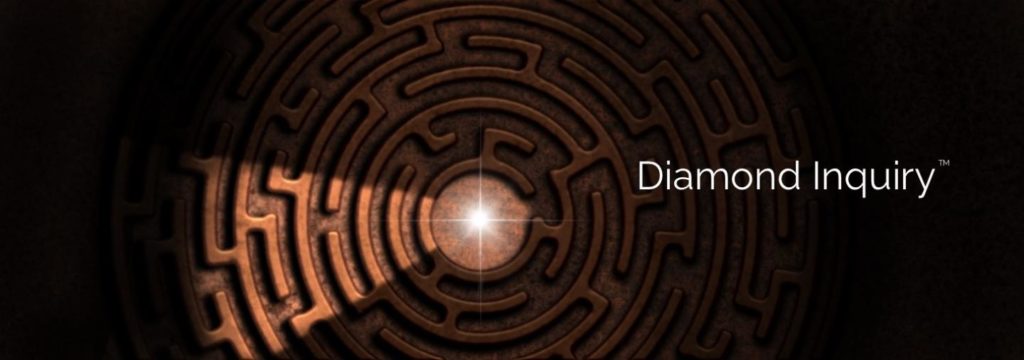
An Overview of the Diamond Approach to Self-Realization
by A. H. Almaas
The Diamond Approach is a contemporary spiritual teaching that developed within the context of awareness of both ancient spiritual teachings and modern depth psychological theories; hence the perspective of this teaching recognizes the inherent synthesis between the spiritual and the psychological domains of experience.
The spiritual and the psychological can be separated only in theory, for in experience, they are two dimensions of the same human consciousness. Recognizing this truth makes it possible to approach the path to inner realization informed with modern psychological knowledge. Thus, understanding one’s psychological experience opens one’s consciousness to the deeper truths of our spiritual nature.
This teaching approaches the path by considering, amongst other things, the structure of reality, both inner and outer. It views reality as fundamentally the eternal truth of spirit that manifests itself in various dimensions, from the deepest dimension of absolute emptiness to the physical realm. The appearance of this manifestation is what is conventionally known as reality, including the physical universe and all beings with their minds and psyches. The inner truth of this reality is true nature itself, pure spirit, which is the ultimate and real nature of the universe and all beings.

View of Spirit
The Diamond Approach views true nature to be both unmanifest and manifest. The unmanifest is totally nondifferentiated and without qualities, a mysterious darkness and emptiness in which consciousness is annihilated as it approaches. Yet this nonmanifest absolute truth holds in virtuality all potential. By manifesting it creates the world with all its forms and transformations, which becomes the appearance of reality; but it also manifests its own inherent perfections and characteristics, which become the inner truth of reality.
It is significant and central to the understanding and the methods of the Diamond Approach that manifest true nature possesses a structure, a structure that gives our experience its fundamental building blocks and capacities of perception and action. In other words, as the nonmanifest absolute manifests it differentiates into dimensions and qualities, so what is virtual and potential becomes actual and experienceable. Spiritual realization is most fundamentally the recognition and embodiment of these dimensions and qualities of true nature, as differentiations of the eternal spirit.
True nature manifests its fundamental characteristics in five basic dimensions, all infinite, boundless and coemergent with each other:
- First is the dimension of absolute emptiness, which is responsible for the arising of space in both inner and outer perception.
- Second is the dimension of pure nonconceptual awareness, the clear light responsible for our capacity for perception.
- Third is the dimension of pure presence, where being and the knowing of being are the same thing, responsible for our capacity for discriminating knowing.
- Fourth is the dimension of pure universal love, where presence is sweet and appreciative, which is responsible for the arising of felt qualities and affects.
- Fifth is the dimension of the logos, which is the dynamic dimension underlying all change, movement, and transformation, responsible for our activities and functionality.
These dimensions form an ontological hierarchy, in the sense that they become more differentiated and knowable and less subtle as they move from absolute emptiness outward. They are, however, not a temporal hierarchy and are fundamentally inseparable, for all dimensions of true nature are coemergent, giving manifest true nature a structure. Each one of them is true nature, spirit itself, and not something else that true nature produces. They are its originally virtual characteristics which by manifesting display its possibilities. These dimensions function as the ontological ground of all appearance, all phenomena, and all experience. [See Diamond Heart, Book IV, by author]
Structure of Spirit
This structure of true nature is reminiscent of the notion of the great chain of Being that many teachings and philosophies have developed. Plotinus, for instance, postulated three basic dimensions, one emerging from the other: the One, which corresponds to our unmanifest absolute truth; the Nous or divine mind, which corresponds to our dimension of pure presence; and the Soul, which corresponds to our dimension of the logos. In our times, Ken Wilber, in his far-reaching theory of human experience and development, utilizes the idea of the great chain of Being to ground his theory in a view that integrates all dimensions of reality, from the physical to the spiritual.
Thus, like the Diamond Approach, his theory holds that reality as a whole has a structure based on the dimensions of true nature. However, there is a difference, for he views true nature itself as always structurless and nondifferentiated. For Wilber, spirit is always transcendent and undifferentiated spirit, but for us this is only the dimension of pure emptiness or/and that of pure awareness. Using his terminology, for Wilber spirit is either the causal level, the pure spirit in its total absoluteness and transcendence, or the nondual level, while the psychic and subtle levels are not spirit itself but different kinds of dimensions that are not purely spiritual in nature.
The Diamond Approach sees spirit itself as structured, as we described in the above discussion of the five dimensions of reality or spirit. All five dimensions, not only the absolute dimension, are true nature. This is similar to the five awarenesses of the Dhyani Buddhas in Mahayana Buddhism, which are inherent differentiations that manifest from Buddha nature without becoming anything else. The rays of the rainbow are all light, even though of colored light. In individual experience, one of the dimensions may dominate consciousness, but in reality, all the dimensions are coemergent, and all are differentiations that manifest necessary characteristics of true nature. In other words, they are all differentiations of what Wilber calls the causal dimension, for reality is always a structured but timeless unfolding.

Essential Aspects
True nature also possesses qualities that are the basis of all spiritual qualities known to humanity, qualities that make us human, and which make it possible for us to develop spiritually. Many traditional spiritual teachings postulate spiritual qualities, each according to its own unique logos. The logos of the Diamond Approach views the unmanifest spirit as possessing virtual perfections, inherent but undifferentiated. As true nature manifests its boundless dimensions, it can also differentiate these perfections, or perfect qualities. This is a “horizontal” differentiation of true nature, in contrast to the “vertical” differentiation of the boundless dimensions. In other words, these differentiated perfect qualities can appear in any of the boundless dimensions, by the ground of this dimension differentiating itself into these qualities.
We call these perfections essential aspects, meaning differentiated aspects of true nature or spirit. Each quality remains true nature itself but appears in a differentiated quality necessary for the life of the soul and for the development of human consciousness. These aspects include truth, clarity, spaciousness, intelligence, existence, will, strength, joy, peace, value, love, personhood, identity, and so on. These are all qualities of true nature in all of its dimensions, even when it is unmanifest, for our spiritual nature eternally possesses such perfections. The important point here is that these are horizontal differentiations of the causal dimension, and that such perfections can arise in our experience as differentiated and delineated qualities. They are not affects, images or responses, but the ontological presence of true nature itself appearing qualified with one of these perfections. [See Essence, by the author]

The Soul
True nature manifests not only its dimensions and aspects, but also vital energy and matter, thus constituting all of reality. We do not include energy and matter in the dimensions of true nature because they can be experienced from within their own perspectives, without recognition of their spiritual origins, while the boundless dimensions and the essential aspects can only be experienced as the spiritual presence of true nature.
True nature further differentiates its logos dimension into what we call the souls of sentient beings. More accurately, the human consciousness is nothing but a soul, an individualization of the logos that embodies both true nature and the dimensions of energy and matter. We are each an embodied soul, where our consciousness is nothing but the consciousness of the logos appearing through a particular physical body. Our awareness comes from the dimension of pure awareness; our knowingness, and hence our mind, comes from the dimension of pure presence; and our heart comes from the dimension of pure universal love. Our human and spiritual qualities come from the essential aspects, and our animal characteristics come from the dimensions of vital energy and matter as they arise through the consciousness of the soul.
The soul is an organism of consciousness, where the creative dynamism of the logos appears in an individuated field as a growing and learning person. It is the consciousness that perceives, and the matrix or field where all experience takes place. The soul develops and grows, matures, and learns. It needs to go through this development and learning in order to consciously and knowingly embody its true nature with all of its dimensions and aspects. It begins as an organism of consciousness, grounded in true nature, but dominated by the animal drives of the physical vehicle. In other words, the soul begins with the potential of both the angel and the animal, whose characteristics arise in its experience depending on circumstances and environment.
The soul begins its development through interaction with its environment, especially with its primary caregivers. It is here that the insights of object relations theory and those of self-psychology, contemporary developments in psychoanalytic theory, are useful in understanding how the soul grows and develops, since its initial development is what is referred to as ego development, with its cognitive and affective components.

Ego Development
Initially, the soul grows primarily by internalizing its interactions with its primary caregivers. Such internalized object relations pattern its experience of itself. It begins as a formless organism of consciousness, but the images and impressions from these object relations structure its field of experience, developing it into a sense of being an individual and autonomous person with a recognizable identity. The personal history carried by such ego structure contributes to its particular character and personality.
By its nature ego development of the soul structures its experience through the development of a mental image of self that becomes the primary lens through which it looks at itself and reality. This becomes the basis of dualistic perception and experience, and hence the primary obstacle in spiritual development. Nevertheless, ego development is a natural stage of the soul’s development, necessary for developing its cognitive capacities and ability to live in the world.
In fact, the primary ego structures of the self are patterned according to specific essential aspects; the context of the maturation and essential development of the soul, these structures are transitional phases on the way to essential embodiment. For example, the structure of knowing oneself as an autonomous individual is patterned on the personal aspect of essence, where the soul can experience itself as a spiritual presence and simultaneously as a person who can relate in a real way to others.[See The Pearl Beyond Price, by author]
The other fundamental pattern of ego is the structure of self-identity, which gives the self the capacity to recognize itself and orient its actions. This is modeled according to the essential identity aspect, the point of light and presence that makes it possible for the soul to abide in its nature in self-realization.[See The Point of Existence, by author]

Realization
As an ego-self, the soul is unaware of its true nature, and its experience of itself is largely patterned by mental structures created in the past. However, even these structures reflect and point to elements of its true nature. By being aware of one’s inner states, and inquiring into them in an open and open-ended manner, the soul can begin to see these states for what they are, soul states patterned by mental structures from early childhood, with their related affects and memories. Seeing the mental nature of this structuring can then allow the soul to stay open without being completely patterned by mental images. This then opens up the inner dimension of space, allowing the arising of the essential aspects related to the associated ego structures.[See The Void, by author] The soul begins recognizing its spiritual potential as states of presence qualified by the perfections of Being.
The method of inquiry is a central practice in the Diamond Approach. Inquiry is a particular application of a manifestation of true nature that functions as inner guidance. This guidance also leads the soul to a direct experiential understanding of a situation. The arising of the essential aspects connects the soul to its essence and opens it to its inner essential guidance. While working in the Diamond Approach, the soul learns the appropriate attitude or inner posture that engages this essential guidance, which leads the soul towards deeper exploration of its experience and life.
Other essential aspects arise with the insight and understanding which arise from the inquiry until the major ego structures are finally seen clearly, confronted, and understood. This process ushers the soul into the boundless dimensions of true nature, which allows the soul to perceive and appreciate a more vast view of reality. Along with this greater perspective, the soul comes to a more objective understanding of itself, of the relation of the soul to both true nature and reality. Thus the process of inquiry becomes a path of freedom and inner realization, leading to a deeper and more comprehensive realization of true nature.
Diamond Inquiry

In the Diamond Approach, the inquiry through which the soul explores the self and its experience is informed by the insights of depth psychology. Here modern psychological knowledge becomes quite useful to support the understanding and transcendence of the ego-self. The field of transpersonal psychology has articulated the need for psychological work in the spiritual journey. Ken Wilber, in particular, has pointed out the usefulness of the insights and methods of object relations theory in particular stages of the inner journey.
The method of the Diamond Approach shares this perspective but makes it more specific and develops it in different directions. The method uses the insights of object relations theory, amongst others, not only to see through general conditioning from past experience, but to specifically understand and penetrate particular ego structures that are precisely related to associated essential aspects. It inquires into the structures of experience that ultimately reflect the structures of true nature. Further, since the primary barriers to inner realization are the mental and dualistic tendencies of the self, it explores these barriers directly and specifically, by inquiring into the underlying ego structures. So psychological knowledge is useful for the support of the process of inner realization not only in general, and not only at certain stages, but specifically and at all stages where ego structures pattern the experience and action of the soul. We find that such structures are actually what patterns conditioned experience at all stages of the inner journey, where the deeper we are in the journey the more fundamental and basic are the structures we encounter.
The method of the Diamond Approach inquires into the structure of reality as a whole, ego structures, essential structures, and the structures of the universe. The entry into the boundless dimensions of true nature reveals them as the necessary underlying ground for the true inquiry, which makes it possible to objectively understand and penetrate the patterns and structures of perception and Being. This inquiry synthesizes modern psychological knowledge with meditation practices and attitudes, for the essential manifestation that guides this inquiry has the capacity to simultaneously utilize the knowledge of time and that of timelessness.
